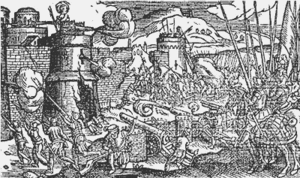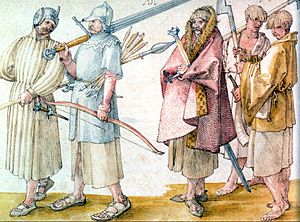Thomas FitzGerald, 10th Earl of Kildare facts for kids
Quick facts for kids
Thomas FitzGerald
|
|
|---|---|
| The Earl of Kildare | |
 |
|
| Reign | 1534–1537 |
| Predecessor | Gerald FitzGerald |
| Successor | Title forfeited |
| Born | 1513 |
| Died | 3 February 1537 (aged 23/24) Tyburn, London, Kingdom of England |
| Noble family | FitzGerald dynasty |
| Father | Gerald FitzGerald |
| Mother | Elizabeth Zouche |

Thomas FitzGerald, 10th Earl of Kildare (born 1513 – died 3 February 1537), was an important person in Irish history during the 1500s. He was also known as Silken Thomas (in Irish: Tomás an tSíoda).
Early Life
Thomas FitzGerald was born in London in 1513. His father was Gerald FitzGerald, 9th Earl of Kildare, the 9th Earl of Kildare. His mother, Elizabeth Zouche, was a distant relative of King Henry VII. After his mother passed away, Thomas was raised by Janet Eustace, the wife of his father's steward.
We don't know much about Thomas's very early years. We do know he spent some time at the English royal court. He also married Frances, the youngest daughter of Sir Adrian Fortescue. It's not clear if this marriage happened before or after his father returned to Ireland in 1530.
In February 1534, Thomas's father was called to London. He made 21-year-old Thomas, who was then known as Lord Offaly, the deputy governor of Ireland. This meant Thomas was in charge while his father was away. In June 1534, Thomas heard rumors that his father had been executed in the Tower of London. He also heard that the English government planned to do the same to him and his uncles.
The Kildare Rebellion (1534–1535)

Thomas decided to act. On June 11, 1534, he called a meeting of the council at St. Mary's Abbey, Dublin. He arrived with 140 armored gallowglass soldiers. These soldiers had silk fringes on their helmets, which is how Thomas got his nickname, "Silken Thomas." At the abbey, he publicly announced that he was no longer loyal to his cousin, King Henry VIII, who was the Lord of Ireland.
The Chancellor, Archbishop John Alen, tried to convince Thomas not to make such a quick decision. But Thomas's harper, who only spoke Irish, saw that Thomas might be changing his mind. The harper began to play a song praising Thomas's ancestors and telling him not to wait. This made Thomas determined. He threw down the sword of state, which was a symbol of his power, and left the hall with his followers.
The council ordered his arrest, but the Lord Mayor of Dublin didn't have enough soldiers to stop him. Many of his father's old friends tried to talk sense into him, but Thomas would not change his mind. As Lord Deputy, Thomas controlled most of the fortresses and large government supplies in the Pale, which was the area around Dublin controlled by the English.
Only Dublin Castle remained loyal to the King of England. Lord Offaly, as Thomas was known, called on the lords of the Pale to help him attack the Castle. Those who refused to promise loyalty to him were sent as prisoners to his Maynooth Castle. He declared that any goods belonging to the King's supporters would be taken. He also said he would exile or kill anyone born in England.
Thomas sent messages to his cousin and friend, Lord Butler, offering to share the kingdom if Butler joined him. But Butler refused. Thomas also took children from Dublin citizens as hostages to make sure the city behaved.
In July, Thomas attacked Dublin Castle, but his army was defeated. He was blamed for the death of Archbishop Alen, who had tried to help. This made many church leaders stop supporting him. It's said that the killers misunderstood Thomas's Irish order to "take this fellow away" (Beir uaim an bodach) as an order to kill Alen.
By this time, Thomas's father had become ill and died in London. This meant Thomas technically became the 10th Earl, but the King never officially recognized his title. Thomas retreated to his strong castle at Maynooth. However, in March 1535, an English force led by Sir William Skeffington captured Maynooth Castle. They did this by bribing a guard while Thomas was away gathering more soldiers. The soldiers who surrendered at the castle were killed. This event became known as the "Maynooth Pardon."
Thomas had wrongly believed that many people, especially Catholics who were against King Henry VIII's English Reformation, would support his cause. But Henry's new rules also went against Lutheranism, and the King was not fully removed from the church until 1538.
In July, Lord Leonard Grey arrived from England as the new Lord Deputy of Ireland. Thomas saw his army getting smaller and his allies giving up. He asked for forgiveness for what he had done. Thomas was still a strong opponent, and Grey wanted to avoid a long fight. So, Grey promised Thomas's safety and convinced him to surrender to the King.
Legend says that Silken Thomas played a lute under the branches of the Silken Thomas Yew tree, which is now the oldest planted tree in Ireland. He supposedly did this the night before he surrendered to King Henry VIII. In October 1535, Thomas was sent as a prisoner to the Tower of London. Despite Grey's promise, Thomas was executed with his five uncles at Tyburn, London, on February 3, 1537.
The "Attainder of the Earl of Kildare Act 1536" was passed to allow his execution and for the King to take all his property. This law stayed in place for a long time until it was removed in 2005.
Silken Thomas's rebellion made King Henry VIII pay more attention to Ireland. It also led to the creation of the Kingdom of Ireland in 1542. The powers of the lords deputy were reduced, and new policies were introduced. To make the country safer, the Royal Irish Army was created as a permanent army.
See Also
Images for kids



